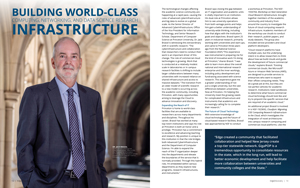The technological changes affecting the academic science community are happening at a rapid pace, causing the roles of advanced cyberinfrastructure and big data to evolve on a global scale. As the Senior Director of Advanced CyberInfrastructure, Office of the Vice President for Information Technology, and Senior Research Scholar, Department of Computer Science at Princeton University, Dr. Jack Brassil is witnessing this extraordinary shift in scientific research. “The cyberinfrastructure and collaboration that researchers need to conduct their work is an important driver of this change. The role of commercial cloud technologies is growing. Work that is conducted at a relatively modest scale in laboratories or in campus research facilities is shifting to include larger collaborations between many universities with increased reliance on shared infrastructure and access to massive datasets.” The transition from an older model of scientific research to a new model is occurring across the academic community, including Princeton, with many opportunities arising to leverage the Cloud to advance innovation and discovery.
Expanding the Reach of IT
Princeton is home to world-class facilities that are available to researchers across many departments and disciplines. Throughout his career, Brassil has worked at many top-notch institutions and says his role at Princeton is both an honor and a privilege. “Princeton has a commitment to excellence and advancing teaching and research. My position is unique to this institution in that the role bridges both Advanced CyberInfrastructure and the Department of Computer Science. I’m able to expand the reach of the IT organization deeper into the departments and elevate the boundaries of the service that is normally provided. Through this hybrid role, I’m embedded within various departments as they explore new programs, research infrastructures, and instruments.”
Brassil says closing the gap between an IT organization and academic units is vitally important to an institution. His dual-role at Princeton allows him to see university operations from both vantage points and helps him gain a better understanding of university-wide thinking, including how that aligns with the institution’s goals and objectives. Brassil spent 25 years in industrial research, primarily working with universities and start-ups, and came to Princeton three years ago from the National Science Foundation (NSF).“This experience was instrumental in preparing me for the kind of innovative work I’m doing at Princeton,” shares Brassil. “I was able to learn more about the overall national and international research enterprise and the inner workings, including policy development and fundraising associated with science research. This experience gave me a greater understanding of not just a single university, but the vast differences between universities. Now at Princeton, I’m helping the University meet the growing needs for complicated infrastructure and instruments that academics are increasingly calling for to complete their research.”
“Edge created a community that facilitated collaboration and helped New Jersey create a top-tier statewide network. GigaPOP is a tremendous opportunity to consolidate resources in the state, which in the long run, will lead to better economic development and help facilitate more collaboration between universities and community colleges and the State.”
–Jack Brassil

The Future of Cloud Technology
With extensive knowledge of cloud technology and the future of cloud-based research facilities, Brassil was approached by NSF to conduct a workshop at Princeton. The NSF-1934704, Workshop on Next Generation Cloud Research Infrastructure, brought together members of the academic community and industry from around the country to investigate the future of cloud computing research infrastructure. Academic members of the workshop use clouds to conduct their research, publish papers, and study datasets. The group also included service providers and cloud platform developers.
“Cloud research platforms have multiple uses, but the underlying intent is to allow researchers to think about how we build clouds and guide the development of future commercial clouds,” explains Brassil. “Existing commercial clouds, like Microsoft® Azure or Amazon Web Services (AWS), are designed to provide services to enterprises who want to expand their offsite computing needs. They do a great job at this, but they are not perfect vehicles for academic research. Institutions need sandboxes to determine what future commercial cloud technology should look like and try to pinpoint the specific services that are required of an academic cloud.”
An additional project Brassil is involved in is NSF-1923692, CloudJoin: Migrating CISE Computing Research Infrastructure to the Cloud, which investigates the integration of novel architectures into campus research computing and commercial cloud platforms. Like the workshop, this project focuses on how to build cloud computing infrastructure that is tailored to academic scientific research. “Academic research institutions host a central IT research computing organization to provide researchers with the campus tools, storage, and computing requirements they need to do their job,” says Brassil. “Those services struggle to meet the demands of today, especially with the need for massive computing jobs and datasets.”
“Academics are at a place of transition,” Brassil continues, “Moving from using extensive, local equipment on campus to shared instruments, shared computing, and commercial cloud resources.” CloudJoin is exploring hybrid clouds, which integrates on campus computing resources with commercial cloud resources. “A hybrid model provides researchers with the comfort of working with familiar, local tools, combined with the scale, reach, and collaboration opportunities of a commercial cloud.”
Supporting Education and Innovation
Princeton, in conjunction with Edge and Rutgers University, created New Jersey’s first Internet2 GigaPOP access point earlier this year. Internet2 is the nation’s premier backbone for conducting research that supports education and innovation. The Internet2 GigaPOP is the first in-state connection to the national and global research infrastructure. “Edge created a community that facilitated collaboration and helped New Jersey create a top-tier statewide network,” shares Brassil. “GigaPOP is a tremendous opportunity to consolidate resources in the state, which in the long run, will lead to better economic development and help facilitate more collaboration between universities and community colleges and the State.”
With the creation of this access point, Princeton, a long-time Edge member, is now connected to an advanced technology community. “This opportunity ties back to Princeton’s desire to be fully connected and engaged in local communities,” says Brassil. “As seen in other regional networks in the country, I think the potential impact on both workforce and economic development is fantastic and will help further drive innovation and discovery. This collaborative environment also creates a center of knowledge for institutions to call upon for support as they develop new cyberinfrastructure.”
Princeton, Rutgers, and Edge are also key participants in a NSF-funded network research infrastructure called FABRIC. The four-year project is intended to support exploratory research in computer networking, distributed computing systems, and next-generation applications. FABRIC involves network elements that are equipped with large amounts of compute and storage that are interconnected by high speed, dedicated optical links. Connecting several testbeds and high-performance computing facilities, FABRIC provides access to cutting-edge network technologies and aims to advance cybersecurity, integrate machine learning and artificial intelligence, and help train the next generation of computer science researchers.
EdgeDiscovery Advisory Council
Edge is dedicated to forging pathways for innovation and engagement among researchers and other stakeholders in the scientific discovery domain. Through EdgeDiscovery, members can pursue their research goals by accessing the advanced computing, support, training, and community engagement they need for success. The EdgeDiscovery Advisory Council was created to bring together fellow forward-thinkers and visionaries and provide a forum for supportive and informative collaboration. “Edge taking a leadership role is terrific. My hat is off to Dr. Forough Ghahramani for having the vision and insight to bring together people from different institutions to lead collaborations between universities and the State,” says Brassil. “Council members will help inform each other of what’s going on at the different institutions in New Jersey. By doing so, we’ll gain a collective understanding of group economic development and important technologies and how we can help support each other in our teaching and research missions — driving success for all.”
To learn more about EdgeDiscovery and tapping into the power of research collaboration and connectivity, visit NJEdge.net/research.



